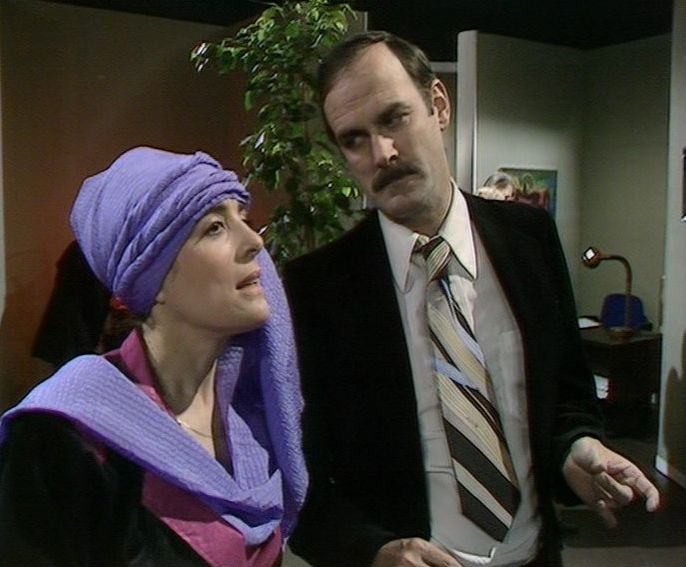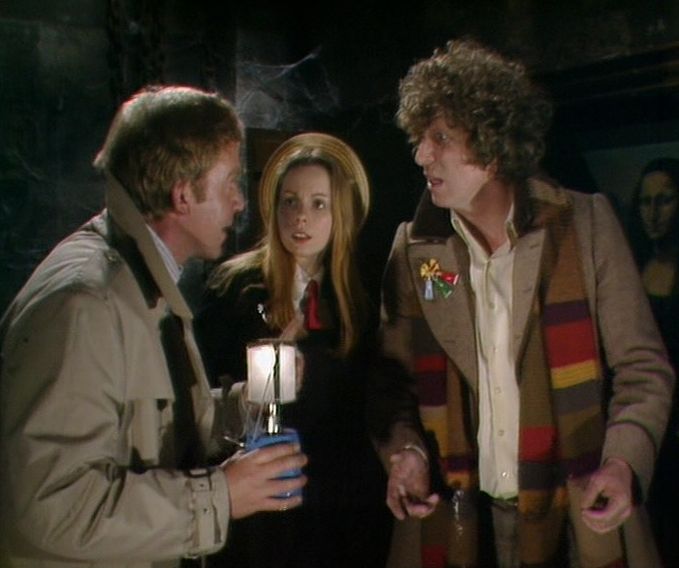
Gan’s limiter has malfunctioned and it’s turned him into an uncontrollable psychopath. Although Blake and the others manage to subdue and sedate him, it’s obvious that he needs urgent medical attention. After reviewing the various options, Avon mentions to Blake that the nearest facility, XK-72, would be ideal.
Zen refuses to take the Liberator on a direct course (due to unspecified dangers) so Jenna has to pilot the ship without computer assistance in a desperate race against time. But although they eventually reach their destination, can they they trust the brilliant surgeon Kayn (Julian Glover)?
Poor Gan. Always something of a third wheel, even this episode (in which he ostensibly takes centre-stage) doesn’t really do him any favours. The main problem was that he was just too nice and affable. Blakes 7 thrived on character conflict – you could take any two from the remainder of the crew (Blake, Avon, Vila, Jenna, Cally) and instantly an interesting dynamic would be created. For example, Blake/Avon, Avon/Vila, Vila/Jenna, Cally/Blake, etc. But teaming Gan up with anyone else never worked nearly as well because of his status as a friendly everyman. True, there was a slight edge between him and Avon, but then Avon disliked everybody!
And whilst the others were defined partly by their skills (Blake the organiser, Avon the computer expert, Vila the locksmith, Jenna the pilot, Cally the telepath) Gan had little to offer apart from his strength. So he was fated to remain a background player, constantly overlooked in favour of the other, more dynamic, crew-members.
It’s therefore ironic that Breakdown – the one episode in which his problems are the main part of the story – doesn’t allow him a great deal of effective screen-time either – he spends the majority of it either unconscious or in a mad rage. So basically Gan just becomes a piece of malfunctioning machinery which Blake and the others need to fix.
Having said that, he does have one good scene. Gan is under restraint in the Medical Room (both for his own safety as well as the safety of the others). Although the limiter is causing him extreme pain, he’s still devious enough to pretend that he’s fine.
CALLY: How are you feeling?
GAN: Tired. Very tired. What’s been happening?
CALLY: You were ill. We’re trying to get to a place where you can receive medical treatment.
GAN: I’m all right. Just that I, I can’t remember. Why am I being held down like this?
CALLY: When the pain was too much for you, you became violent, and we were frightened you might harm yourself.
GAN: I’m sorry, I just can’t remember. I’d like to sit up. Help me, will you, Cally?
CALLY: I think you should stay where you are until we can get help.
GAN: I’m all right. A bit uncomfortable. I’d like to sit up.
CALLY: There is some turbulence. You’re safer where you are.
But Cally does release him and by way of thanks he throttles her. Although brief, it’s a disturbing moment – not only for the visual image, but also for the questions it raises. We know that Gan was a convicted murderer – but was that a one-off crime or is the malfunctioning limiter now showing us his true nature? This would have been a fruitful area to explore in a future story, but alas it was never exploited.
Gan’s opening fight with Blake is good fun and it’s also quite noteworthy as director Vere Lorrimer chooses to shoot it with a hand-held camera. This style of shooting is commonplace now, but at the time it was quite rare. It helps to add a little punch to what is otherwise a fairly static episode (that’s unavoidable since the majority of it takes place on the Liberator).
Breakdown was clearly written as a budget-saving show. Apart from the regular Liberator set, we only see a small office on XK-72 (which looks like Servalan’s office, redressed) and there’s just three guest actors. But it’s a great consolation that one of them is Julian Glover. Glover is someone who seems incapable of giving a bad performance and his presence helps to boost the second part of the episode considerably.
Before they reach XK-72, they have to brave the terrors of the unknown. This is a fairly blatant plot device to slow their journey down and if it works at all it’s because the regulars convince us that they’re in danger. Although this section of the story does drag a little, there’s the odd dialogue gem, such as –
AVON: Blake, in the unlikely event that we survive this …..
BLAKE: Yes?
AVON: I’m finished. Staying with you requires a degree of stupidity of which I no longer feel capable.
BLAKE: Now you’re just being modest.
The other interesting part of Breakdown is the way in which it shows us where Avon’s loyalties lie. Blake and Avon discuss various likely places that could treat Gan. Avon dismisses one and tells Blake that because it’s six hundred hours away “you haven’t anything like that much time.” It’s a moment that goes unremarked, but the fact Avon says “you” and not “we” helps to highlight that he still sees himself as an outsider – Gan is Blake’s problem, not his.
Later, his loyalty is put to the test when he considers leaving the Liberator and remaining on XK-72. Whilst visiting the facility, he’s told that Federation pursuit ships are on their way. He knows he could stay in safety on XK-72 but decides to go back and warn the others. When he returns he also backs up Vila who’s persuading the reluctant Kayn to begin his operation on Gan (Kayn is the one who’s called for the Federation and earlier declared he had no intention of operating). Avon’s decision to return to the ship is a key moment, but it’s another character beat that’s underplayed – he’s the only one who knows he had a chance to escape and it’s obvious he won’t share this information with the others.
The operation succeeds, but the bad shooting of the Federation pursuit ships has serious consequences for XK-72 (“say goodbye to one bolt hole” remarks Avon). Minus points for the final scene featuring all the Liberator crew having a good laugh – partly because these endings are reminiscent of Star Trek (Spock and McCoy clashing, whilst Kirk looks on with a grin) but mostly because it seems a little off, especially since XK-72 is now a smouldering ruin.















